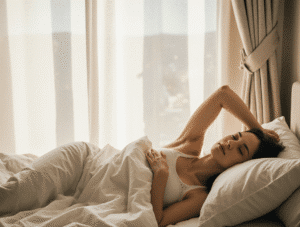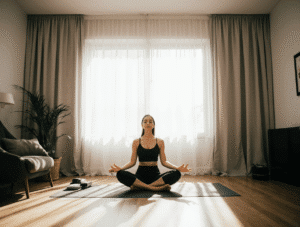Morning light is not just pleasant. It is potent biology in action. Your brain reads that first light as a time cue. It resets clocks in nearly every cell (LeGates et al., 2014). This is the quiet power of morning light at work. The effect is subtle in a moment. Over days, it shapes sleep, mood, and energy. It can even steady your appetite and focus.
I speak from habit, too. Sleeping with the curtains partly open feels natural to me. That way, a soft glow reaches the room at dawn. In full darkness my brain clings to sleep. With dim morning light, it releases the night. I wake faster and feel more present.

Why light rules your inner clock
The human body follows a near-24-hour rhythm, known as the circadian cycle. Light is the most powerful cue for this system. Specialized retinal cells, distinct from those used for vision, detect brightness and send signals to the brain’s master clock in the suprachiasmatic nucleus. From there, timing information spreads throughout the body, adjusting hormones, body temperature, and sleep pressure (LeGates et al., 2014).
The timing of light exposure makes a major difference. Bright light in the early morning tends to advance circadian rhythms, making people feel sleepy earlier in the evening and wake earlier the next day (Khalsa et al., 2003). In contrast, exposure to bright light late at night can delay the clock, shifting sleep and wake times to later hours (St Hilaire et al., 2012). Classic laboratory experiments mapping the “phase response curve” confirmed these effects by applying controlled pulses of bright light at specific times, with results showing clear and predictable shifts.
Morning light, melatonin, and alertness
Melatonin signals biological night. Darkness triggers it. Light suppresses it. Even ordinary room light can change its timing. A large study found that evening room light delayed melatonin onset and shortened its duration (Gooley et al., 2011). Morning light helps flip the script. It suppresses residual melatonin sooner. You then feel more alert after waking.
Outdoors, the effect strengthens. Daylight is intense compared to indoor light. A cloudy morning outside can still beat office lighting by far. Field studies show this contrast. When people live with more natural light by day, their clocks shift earlier. When they cut light at night, their timing also moves earlier. Weekend “camping” studies made this vivid. A few days in natural light advanced circadian timing without alarms (Wright et al., 2013).
Why winter mornings feel harder
Many people struggle more in winter. I do as well. The sun rises late. We wake in the dark and feel heavy. That is not just mood. It is biology again. The dawn signal is weak or absent. The circadian clock stays later than our schedule. Social demands then pull us up before our clock is ready.
Winter also brings shorter days. For some, the cut in daytime light affects mood. Seasonal affective disorder (SAD) is a strong example. Bright light therapy helps many patients. Meta analyses and reviews support its use. Morning sessions often work best. The timing amplifies the dawn signal to the clock.
What morning light does for mood and learning
Light shapes more than sleep. It also touches mood and cognition. The same retinal cells that track light send signals to mood centers. Irregular light can harm mood even without large sleep loss. Regular morning light does the opposite. It steadies rhythms, and this shows the true power of morning light. It supports learning and emotional balance. A leading review explains these links and the brain pathways involved.
The daily routine that works
You do not need a mountain sunrise. Small, steady steps add up. Try this plan. 
Go outside soon after waking. Ten to thirty minutes can help. Cloudy days still count. Natural light is richer and stronger than indoor light. If you cannot go outside, sit by a bright window. Then add a short walk when you can. Field data suggest that more morning daylight shifts timing earlier.
Keep evenings dim. Avoid bright overhead lights near bedtime. Even under 200 lux, evening light can delay melatonin. Warm, low lamps help. So does using fewer screens at night. If you must use them, lower brightness and add night modes. The goal is simple. Give your brain a clear signal: night has begun.
Be consistent across days. Your clock learns patterns. Morning light at a steady time works best. Late night light at random times confuses the system. Over weeks, steady cues win. The result is earlier sleepiness and more natural waking. Field studies in both summer and winter support this.
Consider a light box in dark seasons. Some people benefit from bright light devices. They can deliver 2,500–10,000 lux safely when used as directed. Reviews support their use for SAD and some non seasonal depression. Discuss with a clinician if you have eye disease, migraine, or bipolar disorder. Timing and dose matter. Morning use is common because it advances the clock.
How timing fine tunes results
Let’s return to the phase response curve. If you add light too late at night, you may delay your clock. Then mornings feel worse. If you add light in the early morning, you advance it. That eases waking and moves sleep to an earlier hour. Controlled lab studies measured these shifts. Even one hour of bright light can change timing. The effect depends on when you deliver it.
This is why the power of morning light is special. It is not only the brightness. It is the timing relative to your current clock. Dawn light lands on a sensitive part of the curve. It can nudge your rhythms earlier day by day.
The role of behavior around light
Light is the main cue. But behavior helps the cue stick.
Wake time: Try a set wake time all week. Then add light soon after. Your clock will align faster.
Movement: A short morning walk pairs light with motion. The two cues reinforce alertness. They also improve mood through separate paths.
Food timing: Eat your first meal after light exposure. That helps peripheral clocks sync with your brain clock.
Evening routine: Dim lights two to three hours before bed. Use lamps at eye level or lower. Avoid bright kitchen lighting late at night. That light can be surprisingly strong.
Screens: Keep the last hour before bed screen light free if you can. If not, reduce brightness and use warmer tones. But dimming room light still matters most. Lab studies suggest that normal room light alone can push melatonin later.
What to expect when you start
Expect gradual changes. Many people feel a shift within a few days. Falling asleep gets a bit easier. Waking gets a bit easier, too. After a week or two, the pattern strengthens. Weekend camping studies showed even faster shifts with full natural light. Your daily routine is a gentler version of that.
Mood may lift as sleep regularizes. Reviews link stable light schedules with better mood and learning. If winter weighs on you, speak with a professional. Morning light can be part of a larger plan.
My personal take
I love the quiet promise of dawn. Leaving the curtains partly open helps me wake. The dim glow tells my brain that day has begun. In darkness, I tend to snooze and feel slow. With light, I sit up and breathe, and I can truly feel the power of morning light. Coffee then tastes better. Work flows sooner. This tiny habit has a big return.
Troubleshooting common hurdles
“I leave before sunrise in winter.” Use a light box at home after waking. Aim it slightly off axis to the eyes. Follow device guidance and clinical advice. Time the session early, not late. Evidence supports morning light for SAD and delayed clocks.
“My schedule changes a lot.” Anchor one cue: morning light. Even if wake times vary, try to seek light soon after each wake. Keep evenings as dim as your life allows.
“I am still wired at night.” Audit late evening light. Kitchens, bathrooms, and bright LEDs are common culprits. Replace the last hour with low, warm light. Reduce screen brightness. Consider blue shifted night modes as a backup, not a fix.
“I nap late and can’t sleep.” Shift the nap earlier or skip it. Late naps reduce sleep pressure. They also blur the day night boundary.
“I travel east or west.” Use the phase response curve. For east travel, seek earlier morning light at the destination. For west travel, seek late afternoon light. Then dim evening light to avoid delays. Controlled studies show these timed light sessions shift the clock.
A short science primer you can use
- The clock in your brain runs a bit long or short of 24 hours. Light keeps it on time.
- Morning light advances the clock. Late night light delays it. This is the phase response curve.
- Evening room light can push melatonin later. It also shortens its duration. That can erode sleep.
- Natural daylight strongly anchors timing. Even a weekend outdoors can reset you.
- Bright light therapy supports many with winter depression. Morning use is common and studied.

A gentle winter strategy
Winter steals light from the morning. So add it back with intent.
- Wake at a steady time on most days.
- Seek outdoor light within an hour of waking.
- If it is still dark, use a light box as advised.
- Keep nights cozy and dim.
- Keep screens low and short before bed.
- Move your body in the morning if possible.
- Protect weekends from late night light when you can.
These steps add a strong dawn cue to your life. Over weeks, mornings feel lighter again.
Conclusion: let light lead
Morning light is a small daily choice with large effects. This natural cue aligns your clock. Morning light lifts alertness. It also steadies mood. The dawn glow helps fight winter drift and brings a sense of well-being. Open the curtains a bit. Step outside if you can. Protect your nights. Let the power of morning light guide your day. Your biology is ready to follow.
Upgrade Your Mind: 23 Media Platforms for Smarter Living

I’m Victoria, the creator behind Eva My Balance. Passionate about beauty, wellness, sustainable living, and mindful self-care. My mission is to inspire you to live consciously and beautifully—inside and out.


